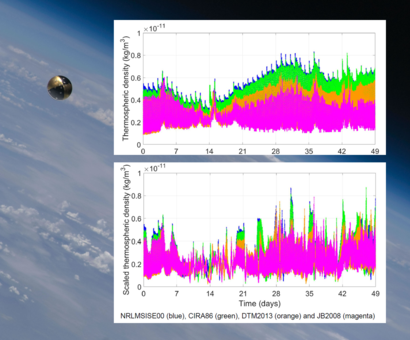New approach to estimate thermospheric density from SLR observations of LEO satellites

The precise knowledge of the density of the Earth’s thermosphere is relevant for satellite mission planning, precise orbit determination (POD), re-entry predictions, and collision avoidances of Low Earth Orbiting (LEO) satellites. Empirical thermosphere models have been derived since the beginning of the space era from observations, e.g., from mass spectrometers and later from accelerometer data of CHAMP and GRACE.
Scientists of DGFI-TUM developed a new approach for the estimation of the thermospheric density using satellite laser ranging (SLR) observations to spherical LEO satellites in combination with a full POD. The approach is based on detailed analysis of the thermospheric drag. The drag coefficient is computed analytically using a gas-surface interaction model. In a case study, the derived procedure was applied to the spherical satellite ANDE-P at a mean altitude of around 350 km. From the analysis of the SLR observations to ANDE-P between August 16 and October 3, 2009, the scientists derived time series of estimated scale factors for the thermospheric density provided by four empirical models (see Figure). The results show that all models overestimate the true thermospheric density along the ANDE-P trajectory during the processed period. Furthermore, the study disclosed the partly high correlations between the thermospheric scale factors and orbital elements of the satellite’s motion. The approach and detailed results are described in the paper Towards thermospheric density estimation from SLR observations of LEO satellites: a case study with ANDE-Pollux satellite (Journal of Geodesy, 2018, DOI: 10.1007/s00190-018-1165-8).
Arcisstraße 21
80333 München